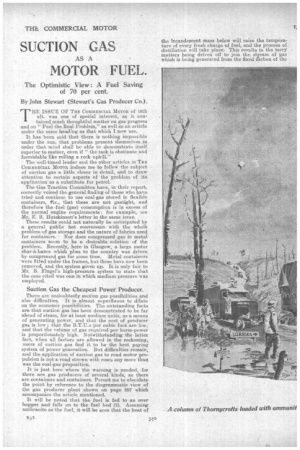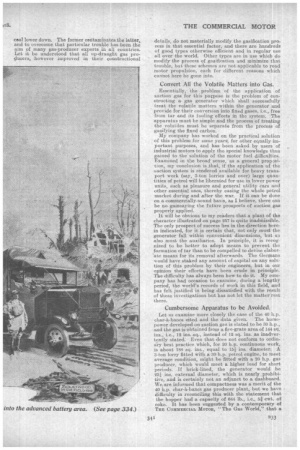SUCTION GAS
Page 10

Page 11

Page 12

If you've noticed an error in this article please click here to report it so we can fix it.
AS A
MOTOR FUEL.
The Optimistic View : A Fuel Saving of 70 per cent.
By John Stewart (Stewart's Gas Producer Co.).
THE ISSUE OF THE COMMERCIAL MOTOR of 16th ult. was one of special interest, as it contained much thoughtful matter on gas progress and on " Fuel the Real Problem," as well as an article under the same heading as that which I now use.
It has been said that there is nothing impossible under the sun, that problems present themselves in order that mind shall be able to demonstrate itself superior to matter, even if " the task is obstinate and formidable like rolling a rack uphill."
The well.-timed leader and the other articles in THE COMMERCIAL MOTOR induce me to follow the subject of suction gas a little closer in detail, and to draw attention to certain Aspects of the problem of its application as a substitute for petrol.
The Gas Traction Committee have, in their report., correctly voiced the general finding of those who have tried and continue to use coal-gas stored in flexible containers, -fir., that these are not gastight, and therefore the, fuel (gas) consumption is in excess of the normal engine requirements : for example, see. Mr. g. B. Hutohinson's letter in the same issue.
These results could not naturally be anticipated by a general public hot conversant with the whole problem of gas storage and the nature of fabrics used for containers. . Nor does compressed gas in metal containers seem to be a desirable solution of the problem. Recently, here in Glasgow, a large motor char-h-banes which plies to the country was driven by compressed gas for some time. Metal containers were fitted under the frames, but these have now been removed, and the system given up. It is only fair to Mr. B. Flugel's high-pressure system to state that the case cited was one in which medium pressure was employed.
Suction Gas the Cheapest Powell' Producer.
There are undoubtedly suction gas possibilities and also difficulties. It is almost superfluous to dilate on the economic possibilities. The outstanding facts are that suction gas has been demonstrated to be far ahead of steam, for at least medium units, as a means. of generating power, and that the cost of producer gas is low; that the B.T.U.s per cubic foot are Tow, and that the volume of gas required per horse-power
• is proportionately high. Notwithstanding the latter fact, when all factors are allowed in the reckoning, users of suction gas find it to be the hest paying system of power generation. But difficulties remain, and the application of suction gas to road motor propulsion is not a road strewn with roses any more that. was the coal-gas proposition.
It is just here where the warning is needed, for there are gas producers of several kinds, as there are containers and containers. Permit me to elucidate the point by reference to the diagrammatic view of the gas producer plant shown on page 257 which accompanies the article mentioned.
It will be noted that the fuel is fed to an over hopper and falls on to the fuel had (3). Assuming anthracite as the fuel, it will be seen that the heat of
the incandescent mass below will raise the tempera turn of every fresh charge of fuel, and the process of distillation will take place: This results in the tarry matters being driven off to join the stream of gas which is being generated from the fixed tarbon of the coal lower down. The former contaminates the latter, and to overcome that particular trouble has been the aim of many gas-producer experts in all countries. Let it be understood that all up-draught gas producers, however improved in their constructional
details, do not materially modify the gasification process in that essential factor, and there are hundreds of good types otherwise efficient and in regular use all over the world. Other types are in use which do modify the process of gasification and minimize that trouble i but these schemes are not applicable to read motor propulsion, each for different reasons which cannot here be gone into.
Convert All the Volatile Matters into Gas.
Essentially, the problem of the application of suction gas for this purpose is the problem of constructing a gas generator which 'shall successfully treat the volatile matters within the generator and provide for their conversion into fixed gases, i.e., free from tar and its fouling effects in the system. The apparatus must be simple and the process of treating the volatiles must be separate from the process of gasifying the fixed carbon.
My company has worked on the practical solution of this problem for some years', for other equally important purposes, and has been. asked by users of industrial motors to apply the special knowledge thus gained to the solution of the motor fuel difficulties. Examined in the broad sense, as a general proposition, my conclusion is .that, if the application of the suction system is rendered available for heavy transport work (say, 3-ton lorries and over) large quantities of petrol will be liberated for use in lower power units, such as pleasure and general utility cars and other essential uses, thereby easing the whole petrol market during and after the war. If it can be done on a commercially-sound basis, as I believe, there can be no gainsaying the future prospects of suction gas properly applied.
It will be obvious to my readers that a plant of the character illustrated on page 257 is quite inadmissible. The only prospect of success lies in the direction herein indicated, for it is certain that, not only must the generator fall within convenient dimensions, but so also must the auxiliaries. In principle, it is recognized to be 'better to adopt means to prevent the formation of tar than to be compelled to devise elaborate means for its removal afterwards. The Germans would have staked any amount of capital on any solution of this problem by their engineers, but in our opinion their efforto have been crude in principle. The difficulty has always been how to -do it. My company has had occasion to examine, during a lengthy period, the world's records of work in this field, -and has felt justified in being dissatisfied with the result of these investigations but has not let the matter rest there.
Cumbersome Apparatus to be Avoided.
Let us examine more closely the ease of the 40 h.p. char-h-bancs cited and the data given. The horsepower developed on suction gas is stated to be 30 h.p., and the gas is obtained from a fire-grate area of 144 sq. ins., i.e., 12 ins. sq., instead of 12 sq. ins, as inadvertently stated. Even thatdoes not conform to ordinary best practice which, for 20 h.p. continuous work, is about 188 sq. ins., equal to 15li ins. diameter. A 3-ton lorry fitted With a30 h.p. petrol engine, to meet . average -condition, might be fitted with a 20 h.p. gas producer, which would meet a, higher load for short periods. If brick-lined, the generator would be 251 ins. external diameter, which is nearly prohibitive, and is certainly not an adjunct to a dashboard. We. are informed that compactness was a merit of the 40 h.p. char-a-banes gas producer plant, but we have difficulty in reconciling this with the statement that the hopper had a capacity of 644 lb., i.e., 54 cwt. of coke. It has been suggested by a contemporary of THE COMMERCIAL MOTOR, " The Gas World," that a in. diameter gas generator might be waterjacketed to keep down the, external diameter, but water jackets so applied favour low wall temperatures and the escape of COLe which is highly objectionable from the producer efficiency standpoint, and also as a component of the final explosive mixture. It has been shown that, beginning with a suitable fire-grate area, ex'ternal dimensions are cumbersome and prohibitive, and while I must at present refrain from detailed description of the proposals of my company, which are well under way, and . which we hope to be able to introduce to the industry soon, .I may state that we conform to the principles laid down, and adhere to best practice in all general respects and, in doing so, we find that the dimensions and weight adjust themselves to reasonable proportions and present convenient possibilities. With the new method of operation and the simplified construction, the apparatus lends itself admirably to the construction of a portable gas plant carried on the chassis frame of a 3-ton lorry. It constitutes, I believe, a straightforward engineering solution of the present fuel difficulty, which is not attainable by any of the existing forms of gas generators. I feel it my duty, in consequence of the prominence which your journal
gives the subject, thus to state the result of our special experience in these matters as the nation, at present, cannot afford to misdirect its energies. True progression in thatransport industry can only be secured by following scientific evolutionary lines. and not by repeating past failures or retreading old and useless tracks.
-It is perhaps desirable to submit in round figures the possible econonnieslo be secured by a suction gas -producer plant for a three-ton lorry. This, if equipped with a 30 lap. engine using petrol at 3s. per gallon and running under full load. for 10 hours at 10 miles per hour would, for six days continuous work cost 213 10s. for petrol. The same work can be done by suction gas, with anthracite at 22 per ton, for 22 assuming ordinary gas engine effiaieneies. To allow for a drop in efficiencies, we may safely say there is still a saving of 210 per week. If operating continuously for a year of 50 weeks, the saving is 2500 per annum at present prices, thus verifying what was recently stated in the "One Hears" column.
Viewed in this way my company considers that suction gas offers every inducement required for successful exploitation to overcome the petrol shortage problem.






















